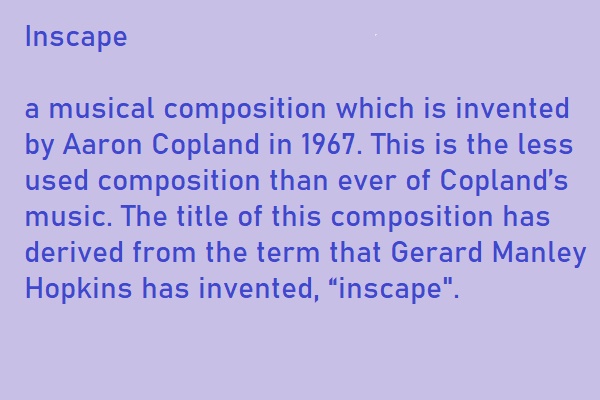Inscape Introduction
Inscape is a musical composition which is invented by Aaron Copland in 1967. This is the less used composition than ever of Copland’s music. The title of this composition has derived from the term that Gerard Manley Hopkins has invented, “inscape”.
This composition is almost around twelve minutes lengthy. Inscape is composed using the twelve-tone technique. Very First eleven-note chord spacing, describes ‘a quasi-mystical illumination, a sudden perception of that deeper pattern, order, and unity which gives meaning to external forms.’

Gerard Manley Hopkins Inscape
Hopkins as a priest poet has to affirm what is the features of a sense. Hopkins’s notebooks are proof of his caring nature and his thoughts. He used to pay extreme attention and detail the natural things. It elaborates how he used to see or think the natural things in a different way.
Gerard Manley Hopkins has invented the term ‘inscape’. The word ‘Inscape’ shows the exact features of a certain place which makes it differentiates it from the others. Hopkins has always believed that God does not ever repeat.
The term inscape brings about the idea of the uniqueness of individuals. It shows how it is individually depending on everyone who ever observes the natural elements.
This idea is partially ancient and it is mostly used in the medieval theological writings. Hopkins, being a poet realizes that how it is important to be subtle and unique in expressing the art through words. In his journals and letters, it is clearly visible.
Inscape demonstration
Gerard Manley Hopkins has invented two commendatory ideas about individuality and uniqueness which are Inscape and stress, from the concepts of the writing of the medieval philosopher Duns Scotus. These two concepts are somewhat contradictory.
Hopkins believed that everything in this world is created by God, the individual design that forms the individual identity. This identity is vigorous. Everything in the universe is individual. Among everything, human beings are the most individualistic.
Finally, the intense energy towards distinctiveness leads the poet to the spirituality for the quest for individual identity of anything in the universe. Hopkins calls the Inscape of other things, instress.
This concept is related to logocentric theology. Creation of logocentric is established on the connection of the Genesis description and John. All the creation is created by God and their identity is distinctive.
Ultimately the holiness lies on every creation of God. To the extent anything and everything God creates is holy. Thus holiness plays an important role in this technique. Since Gerard Manley Hopkins is a priest he brings along the idea of spirituality in his literary works.
Holiness connects the two contradictory terms inscape and instress. Hopkins’s opposition of “inscape” is “instress”.
A critic says about Copland, “uses sounds like an ‘instress’ that communicates a deeper inner essence, an ‘inscape.’
J. R. R. Tolkien describes The same concept. He compares God, the creator with his individual creation.
Inscape in poetry
Gerard Manley Hopkins has used his inscape technique in is poetry. He has used this method mostly to describe a specific landscape. Instress is used to suggest intuition of Hopkins’s inner law. He has used parallel lines.
Hopkins has incorporated two terms, inscape” and instress, in his journals.
The term inscape means the complex description that gives each individual thing its uniqueness and that differentiate it from other things. The term instress means the energy which binds the inscape together.
It is a matter of arguing that Hopkins’s inscape is the parallelism of lines in the poetry. Although it is appropriate for the Hebrew poetry in the case of Hopkins’s poetry, it varies. Such as Hopkins’s poetry is filled with alliteration, metaphor, simile and those can be considered as parallels.
Hopkins binds the inscape of some particular words to establish it. To establish it he has played with sound and sense of inscape of words.
His poetry is complex. He has used Compound words to describe the inscape of poetry. For Hopkin, s the task as a poet is to take two familiar words and create a fusion word. His language of literature needs to be renewed to express inscape.
The theory of inscape is influenced by Wordsworth’s Spots of time, Emerson’s Moments, and Joyce’s Epiphanies. It shows the romantic idea of the Victorian age. But the concept of inscape which Hopkins has produced is somewhat religious. It shows the significance the creator, God and his creation.